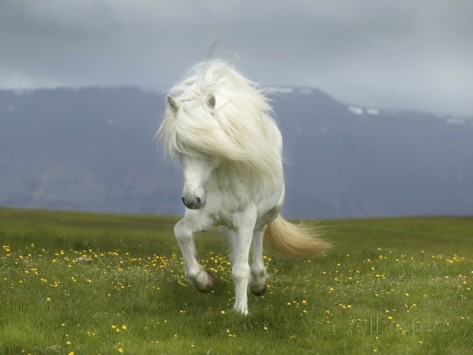When you say “Viking” and “Chieftain” in the same sentence, images of powerful men come to mind. You might also conjure a “wild west” style of lawlessness. This perception is well-earned in some cases. Yet, Viking history and their sagas presents a more nuanced picture. One case in point takes us to Iceland. Last week shared the true tale of Audr the Deep-Minded, an amazing female leader in Iceland’s early days. This week is the true tale of Hrafnkel, the horse loving Icelandic chieftain who broke the law.
Hrafnkel’s (pronounced RAF-kell) story is found in Freysgoða saga. He lived in northeast Iceland in the early 900s, and was known as fair to his own men but harsh to most others. Hrafnkel had a taste for duels and a reputation for not paying weregild(man price) for anyone he killed in a duel.*
He was deeply religious, dedicating the best of his livestock to the god Freyr, including his horse, Freyfaxi (Old Norse: Frey’s horse). Because of his devotion to Freyr, Hrafnkel was known as Freysgoði (Old Norse: Frey’s priest and chieftain). This horse fervor** might seem over the top, but Vikings believe Freyr’s horse had supernatural powers.
Horses were key to Viking survival on Iceland, and a significant part of their lore. Not only was the horse excellent transportation, but Vikings also ate horse meat on Iceland (similar to Mongol culture which used the horse to navigate the Steppes but also ate their mode of transportation).***
But, Hrafnkel was zealous about Freyfaxi. No one was allowed to ride the horse. If they did, Hrafnkel swore he’d kill the rider.
With fanaticism like that, you know something will test it.
It did in the young shepherd, Einar, who worked on Hrafnkel’s mountain farm. Einar had been tasked to collect the sheep. The job wasn’t going well until he spied a herd of Hrafnkel’s horses roaming the same pasture. He decided shepherding would go more smoothly on horseback. Unfortunately, every horse he approached ran away except of Freyfaxi.
Einar knew about the ban. Everyone did.
The young shepherd ignored it. Once the sheep were rounded up, he let Freyfaxi go. The horse immediately ran home, and once there, started neighing.
Hrafnkell figured out what happened when he saw Freyfaxi was dirty and sweaty. The next day the chieftain rode up to the mountain pasture. After a brief exchange of words with Einar, the chieftain reluctantly kept his vow to kill whoever dared to ride Freyfaxi.
Did Hrafnkel the chieftain get away with his crazed vow? No. Hrafnkel was convicted and declared an outlaw.
The saga goes on to tell the story of Hrafnkel’s life as a man on the run.**** Even mighty, ax-wielding Viking chieftains paid the price for lawlessness.
Thanks for stopping by! I hope to see you next week where I’ll share a lighter (but true) tale from Viking history.
-Gina
*Not all duels or fights were fights to the death. A Holmgang was a “first blood” duel used to solve problems. Two combatants faced off and who whoever drew first blood was the winner. It was believed that whoever bled first was the man in the wrong.
**Examples: Odin’s eight-legged horse Sleipnir, Heimdallr’s golden-maned horse Gulltoppr, the jötunn giant Hrungnir’s horse Gullfaxi, and Dagr’s (day) and Nótt’s (night) horses Skinfaxi and Hrímfaxi bringing daylight and night (i.e. hauling day and night behind them like a cart)
***When Iceland was colonized in the late 800’s, Hrafnkel’s father, Hallfreður, brought horses from Western Norway. Freyfaxi was likely similar to today’s Icelandic horse, a blend of Norwegian Viking horses and small horses taken from the British Isles. The Icelandic horses are small but tough. They are one breed that does well in a cold climate.
****Banishment was a popular punishment in Norse society. There was a subculture of Viking outlaws who lived in forests and caves. There are even names for children born of outlaws. The Vikings were a close-knit society on which family and hospitality was the core.





The depth of your research is always evident in your stories. From reading this it looks like the viking word for horse must be “faxi”- how was that pronounced? Just curious. Your posts are entertaining but some of them lead me down research rabbit holes.
Research rabbit holes! We’re of like mind.
Faxi is Old Norse for horse (derived from “fax” which means mane). But you’ll also see hross (old horse or mare) in Old Norse. In fact, there are more versions of the hross spelling when you look to Sweden, Norway, and early Norman (Normandy) word development. A Norman Viking would call a horse “harousse” (I’ve been spending a lot of time with Swedish and early Norman Viking words of late).
People with basic history will say all Vikings spoke the same language during the Viking Age, but this isn’t totally accurate. Yes, someone from Iceland could understand someone from Denmark in the same way someone from Alabama can understand someone from Scotland. But, there were distinct differences.
During the Viking Age, Norway, Denmark, and Frisia used short stave runes when spelling their words. Sweden used long stave runes. Are these “alphabets” (and pronunciations) similar? Yes. Because of busy Viking movement, will you see Swedish Vikings using and understanding short staves? Yes (and likewise Norway and Denmark using and understanding long stave runes). All very similar, yet each region had distinctions. The same is true with longhouses from Iceland to Denmark to Sweden. Just like you see lots of brick houses in Michigan but rarely in California. These Viking Age (defined as 794 AD – 1030 AD) runes were specific and unique to the time. By the 1600s the “letters” evolved into staveless runes. The end result is seeing in the same time period language evolution and regional distinction with words such as horse.
Part of the complexity is the “Elder Futhark” which was the single 24 runic alphabet used by all Vikings for centuries until the Viking Age came. Once the famous raiding era began, the alphabet shrunk to 16 runes (called the Younger Futhark). Sounds and spellings transformed with those changes for Vikings as a whole and then branching off by regions.
Thanks for asking this question. I probably gave too much info. I could say a blanket “yes” to faxi being horse but since most Vikings used hross, harousse, hestor, etc. I had to explain because history is evolving. It’s an exciting time in archaeology. New developments come to light everyday, and it will take years before those revelations show up in places like Wikipedia. For example, one popular misconception is that Iceland had no forest when Vikings settled there. The truth is the highland (central part) of the island was covered in trees and bushes! Now it’s a desert. Iceland’s chronicler Ari Frode wrote in his codex:
AT that time was Iceland covered with woods, between the mountains and the shore. Then were here Christian people, whom the Northmen called Papas, but they went afterwards away, because they would not be here amongst heathens; and left after them Irish books, and bells, and croziers, from which could be seen that they were Irishmen. But then began people to travel much here out from Norway, until King Harold forbade it, because it appeared to him that the land had begun to be thinned of inhabitants.
Overgrazing and chopping down the trees eventually made central Iceland a desert, but not when people first settled.
Thanks for stopping by the blog! I have on the schedule later this year to write about the Futhark. I’ve also long had a fascination with Iceland above all other Viking places. It’s in the plans to visit Iceland in the winter and in summertime.
Have a great day, Diana!
Gina